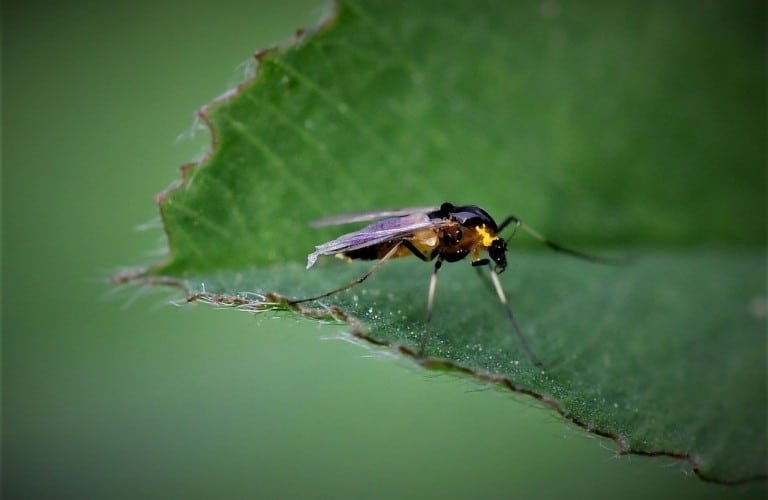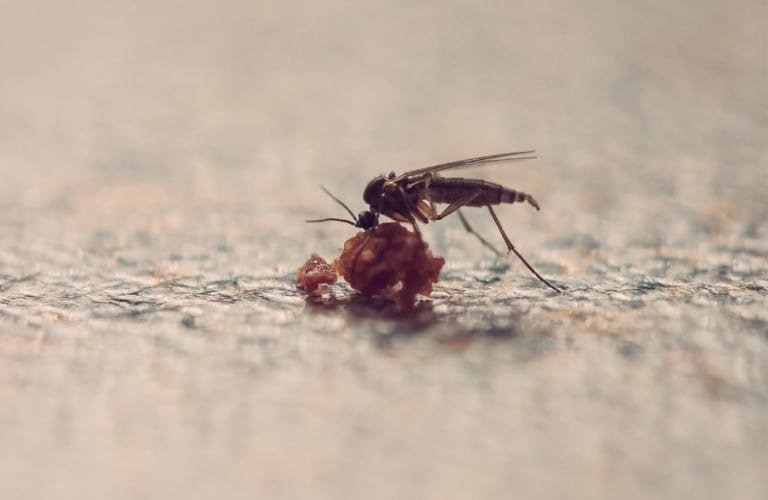While most common types of gnats you come across either outside or the ones that find their way inside your home do not bite or cause harm to people or pets, there are some types of gnats that bite.
Do gnats bite? Many commonly encountered gnats, such as fungus gnats or fruit flies, do not bite. However, females of the biting midge group, such as buffalo gnats and sand gnats, do bite and feed on blood in order to obtain the protein necessary for producing viable eggs.
After reading the following, you’ll know which gnats are harmless and which ones bite and should be avoided.
If you’re dealing with an infestation of gnats right now, know that the answers you need can be found in our article, “How to Get Rid of Gnats.”
Also be sure to check out the most effective traps and sprays for gnats for fast and easy solutions.
Types of Gnats
Nonbiting Gnats
Fungus gnats, fruit flies, and drain flies are among the most common, everyday types of gnats.
They fly around your head outside (find out why here) or go after overripe bananas on the kitchen counter.
These types of gnats look for moisture, feed on flowers, and live in dirty drain pipes or plant soil.
Although moisture is one of the main attractants for gnats, it’s not the only thing they are attracted to.
You’ll find a complete list of what gnats are drawn to in this article.
In case you’re wondering why you often see gnats hovering around your houseplants and outdoor plants that are past their prime, the reason is that fungus gnats like to lay their eggs in the damp soil.
The hatched larvae then feed on soil fungus and plant roots, causing damage and perhaps even fatal injury to the plant.
Female nonbiting gnats do not need blood to produce their eggs.
There are also nonbiting eye gnats, drawn in by carbon dioxide and the mucous membrane secretions around eye ducts of humans and other mammals.
Eye gnats have been connected to passing on conjunctivitis (pink eye) in both humans and livestock.
For help in dealing with nonbiting gnat problems, be sure to visit our entire selection of gnat articles for elimination strategies and prevention tips.
Biting Gnats
Biting gnats are the types who need blood to produce eggs for reproduction. As part of the breeding cycle, only female gnats bite.
These gnats are small, winged insects that easily pass through door and window screens, making it difficult to avoid them if they get inside the house.
Buffalo Gnats
Buffalo gnats, also known as black midges or black flies, are small, black winged insects, much like a tiny housefly, that like to attack livestock and poultry but will also bite dogs and people as they need to feast on a blood meal to produce eggs.
Adult female buffalo gnats lay hundreds of eggs within a couple of weeks after fertilization.
Eggs are laid in water, whether it be running water in a stream or in water-submerged plants near the water’s edge.
Buffalo gnats are small, typically less than ¼ inch with curved black backs and large eyes. The life cycle of a buffalo gnat is only about 30-40 days.
Other than a red and possibly painful bite mark, biting gnats pose no further health threat to humans.
Buffalo gnats cause more damage to animals kept outdoors.
They annoy horses, cows, and chickens by relentlessly biting the animals and flying into their noses, which creates breathing difficulties for them.
These gnats also cause the animals to become stressed or suffer discomfort or pain from repeated attacks and bites.
Large swarms of buffalo gnats have been known to kill poultry and livestock due to excessive bites.
Sand Gnats
Sand gnats, also called sand flies, are also black midges (or little flies) that bite. They are found near water sources like streams, ponds, and marshy wetlands.
Female gnats lay eggs in the wet mud near these watery locations, but before they do, they need protein from blood to produce their eggs.
Females lay about 50 eggs at a time, which hatch and turn into larvae in about a week or two. The complete life cycle of a sand gnat is about 30 days.
An adult sand gnat is just under ¼ inch, brown in color, and covered in hair from their antennae to legs.
They have large black eyes and a sharp mouth used to pierce skin and suck blood. Sand gnats are most active in clear, calm warm summer months.
How to Avoid Biting Gnats
The best way to avoid these annoying pests is to avoid wet, swampy areas in warm summer months particularly around dusk and dawn when biting gnats are most active.
Gnats prefer warm, humid weather with no wind or rain, so consider the following precautions on warm, hazy summer days:
- Wear protective clothing including a long sleeve shirt, long pants, socks, and a hat.
- Wear an insect repellent made with essential oils or try dabbing a smell they hate, like vanilla, on your skin and clothing.
- Wear light-colored clothing to avoid the attention of sand gnats, as they are attracted to dark colors unlike most gnats and flies.
- Light several citronella candles, like these summer-scented soy candles, whenever you plan to be outside for an extended period of time.
- Generously spray a gnat fogger, like this one that treats up to 1,200 cubic feet, around wet, muddy areas outside.
| Preview | Product | Rating | |
|---|---|---|---|

|
Citronella Candles Outdoor, Scented Candles,... | Check Price on Amazon | |

|
Cutter Backyard Bug Control Outdoor Fogger (2... | Check Price on Amazon |
You may also want to consider installing an electric bug zapper in your yard for further control and elimination.
Gnats (and pesky mosquitoes too) will be attracted to the ultraviolet light only to meet certain death when they contact the electric internal grid.
What Triggers Gnats to Bite
Of the biting gnats, only females are out for blood. They need to feed on mammal blood in order to produce viable eggs, and once fed, they go off to lay their eggs.
Adult female buffalo and sand gnats typically feed on nectar unless needing a blood meal for their eggs.
Female biting sand gnats on the prowl for prey are attracted to dark moving objects, shiny surfaces, sweat, and carbon dioxide (released in human breath).
How to Recognize a Gnat Bite
Gnat bites are similar to the look of a mosquito bite but are usually bigger, itchier, and can be more painful. Here are the common signs of a gnat bite:
- More painful than a mosquito bite.
- Similar in appearance to a mosquito bite but instantly and sometimes intensely itchy.
- Bite area can swell quickly.
- Wound area may experience a sharp, burning sensation.
- Pus-filled sacs may develop if infected.
- Sand gnat bites can take up to two months for the scars to disappear.
Gnats Slice Skin
Instead of breaking through skin like a mosquito, female biting gnats use their sharp, jagged, saw-shaped mouth to first slice open the skin before sucking blood out.
Because the skin is sliced instead of pierced, gnats can suck more blood.
They need the protein found in the blood of humans and other mammals for completion of the egg fertilization process.
During an active bite, the gnats inject anticoagulants into the victim’s blood. This can cause a mild allergic reaction in some individuals.
Common Skin Reactions to a Gnat Bite
Mostly, the bite will resemble a big mosquito bite and begin to itch almost immediately. Irritation, swelling and intense itching may follow.
The more you scratch the bite, the greater chance of infection. The bite area may then fill with pus.
If symptoms don’t get better after a few hours or get worse, call a medical professional for further medical treatment or advice.
General Treatment for a Gnat Bite
Whether or not you experience an allergic reaction to a gnat bite, it’s best to treat any kind of insect bite to relieve itching, swelling, and the potential for infection.
Follow these simple steps:
- Clean and disinfect – Clean the bite mark thoroughly with soap and water or use an alcohol wipe to remove dirt and bacteria.
- Treat with an antiseptic or antibacterial cream – Apply medicated antibacterial cream or spray to bite area.
- Calm itchiness – Apply an anti-itch cream like Benadryl Itch Stopping Gel or Gold Bond Pain and Itch Relief on the wound site. Undiluted frankincense essential oil is also excellent at taking the sting or itch out of an insect bite.
See a doctor if symptoms persist or get worse.
If experiencing excessive swelling; allergic reactions like hives, swollen throat, and difficulty breathing; or if green/yellow fluid or pus oozes from the site, contact a doctor immediately.
Summary
Since biting gnats are commonly found in warm, humid places with plenty of moisture, exercise caution in these areas and always use protection.
The best protective measures include:
- Covering as much skin as possible with light colored clothing, including socks and a hat.
- Liberally spray a gnat repellent on skin and clothing.
- Avoid excessively wet areas in warm weather during dusk and dawn when gnats are most active.
- Spray yards with outdoor gnat foggers being sure to cover areas that include dense foliage, grass, and cracks in sidewalks and patios.
- Light citronella candles during outdoor gatherings.
- Place bug zappers, like these (no chemicals, kill on contact), on deck railings or locations on the perimeter of seating areas outside.
By doing what you can to keep biting gnats away from areas where people and pets gather by using foggers and insecticides, you can lessen the likelihood of being bitten by gnats.
Additionally, taking the extra personal measures by covering skin with clothing and repellents helps give an extra layer of protection from the nasty bites of buffalo and sand gnats.
Fighting off gnats is never a pleasant experience, but when you’re armed with the correct information and elimination techniques, the battle can be won.




